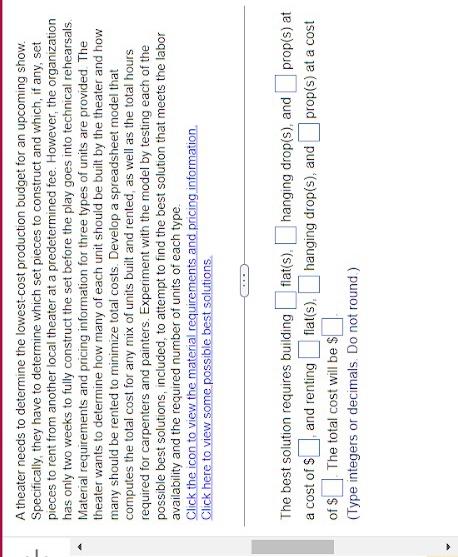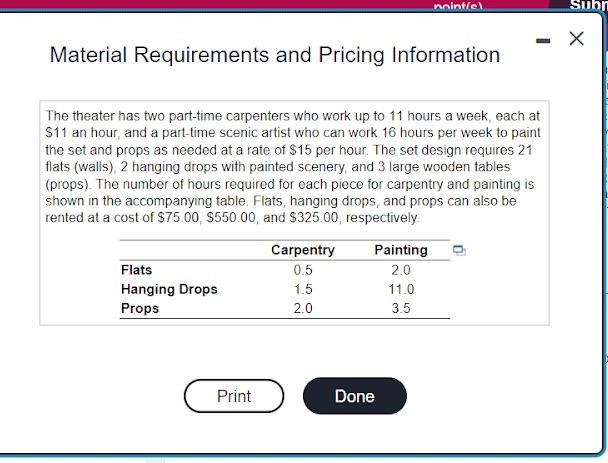A theater needs to determine the lowest-cost production budget for an upcoming show. Specifically, they have to determine which set pieces to construct and which, if any, set pieces to rent from another local theater at a predetermined fee. However, the organization has only two weeks to fully construct the set before the play goes into technical rehearsals. Material requirements and pricing information for three types of units are provided. The theater wants to determine how many of each unit should be built by the theater and how many should be rented to minimize total costs. Develop a spreadsheet model that computes the total cost for any mix of units built and rented, as well as the total hours required for carpenters and painters. Experiment with the model by testing each of the possible best solutions, included, to attempt to find the best solution that meets the labor availability and the required number of units of each type. Click the icon to view the material requirements and pricing information. Click here to view some possible best solutions. The best solution requires building flat(s), hanging drop(s), and prop(s) at a cost of $ and renting flat(s), hanging drop(s), and prop(s) at a cost of $ The total cost will be $ (Type integers or decimals. Do not round) Material Requirements and Pricing Information The theater has two part-time carpenters who work up to 11 hours a week, each at $11 an hour, and a part-time scenic artist who can work 16 hours per week to paint the set and props as needed at a rate of $15 per hour. The set design requires 21 flats (walls), 2 hanging drops with painted scenery, and 3 large wooden tables (props). The number of hours required for each piece for carpentry and painting is shown in the accompanying table. Flats, hanging drops, and props can also be rented at a cost of $75.00,$550.00, and $325.00, respectively. Possible Best Solutions Some possible best solutions to try are listed below. - The solution in which all of the flats, hanging drops, and props are built in-house - The solution in which the theater builds 1 flat, 2 hanging drops, and 2 props - The solution in which the theater builds 5 flats, 1 hanging drop, and 3 props - The solution in which the theater builds 3 flats, 2 hanging drops, and 1 prop A theater needs to determine the lowest-cost production budget for an upcoming show. Specifically, they have to determine which set pieces to construct and which, if any, set pieces to rent from another local theater at a predetermined fee. However, the organization has only two weeks to fully construct the set before the play goes into technical rehearsals. Material requirements and pricing information for three types of units are provided. The theater wants to determine how many of each unit should be built by the theater and how many should be rented to minimize total costs. Develop a spreadsheet model that computes the total cost for any mix of units built and rented, as well as the total hours required for carpenters and painters. Experiment with the model by testing each of the possible best solutions, included, to attempt to find the best solution that meets the labor availability and the required number of units of each type. Click the icon to view the material requirements and pricing information. Click here to view some possible best solutions. The best solution requires building flat(s), hanging drop(s), and prop(s) at a cost of $ and renting flat(s), hanging drop(s), and prop(s) at a cost of $ The total cost will be $ (Type integers or decimals. Do not round) Material Requirements and Pricing Information The theater has two part-time carpenters who work up to 11 hours a week, each at $11 an hour, and a part-time scenic artist who can work 16 hours per week to paint the set and props as needed at a rate of $15 per hour. The set design requires 21 flats (walls), 2 hanging drops with painted scenery, and 3 large wooden tables (props). The number of hours required for each piece for carpentry and painting is shown in the accompanying table. Flats, hanging drops, and props can also be rented at a cost of $75.00,$550.00, and $325.00, respectively. Possible Best Solutions Some possible best solutions to try are listed below. - The solution in which all of the flats, hanging drops, and props are built in-house - The solution in which the theater builds 1 flat, 2 hanging drops, and 2 props - The solution in which the theater builds 5 flats, 1 hanging drop, and 3 props - The solution in which the theater builds 3 flats, 2 hanging drops, and 1 prop









